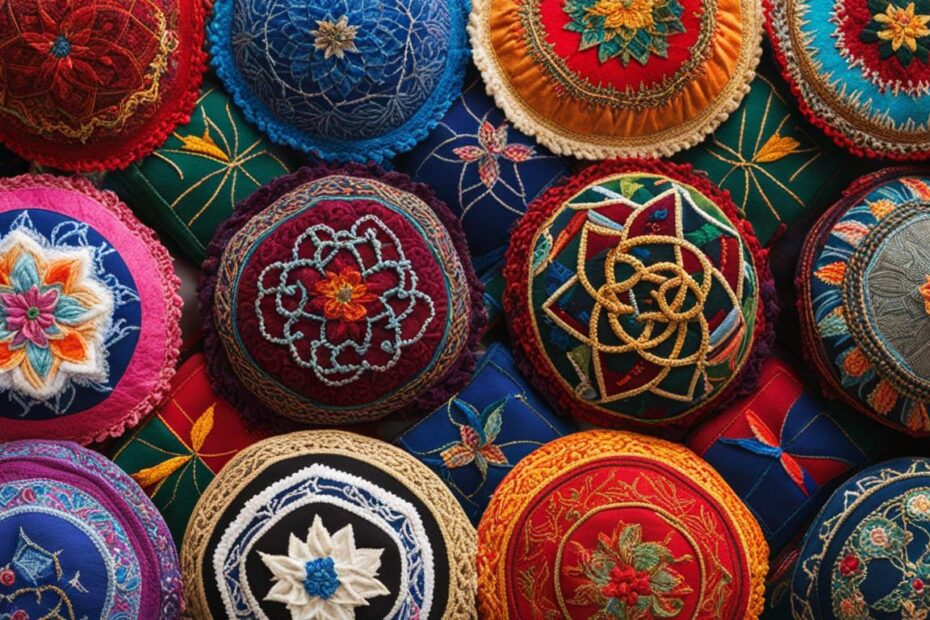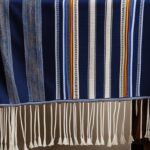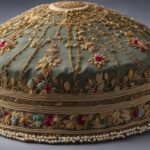The kippah, also known as a yarmulke or skullcap, holds significant cultural and religious importance in Jewish tradition. It is worn by Jewish men as a sign of respect and reverence for God during synagogue services and other religious occasions. The kippah is a symbol of Jewish identity and serves as a reminder of one’s connection to the divine and sense of community among believers.
How are kippahs used in practice? What do these tools symbolize? Are there variations among sects? What materials are used for these tools? How have they changed over time? Are there unique, lesser-known tools? These are some of the questions we will delve into in this article as we explore the rich tradition of kippahs.
Key Takeaways:
- The kippah is a religious headwear worn by Jewish men as a sign of respect and reverence for God.
- It serves as a symbol of Jewish identity and a reminder of one’s connection to the divine.
- Kippahs are used during synagogue services and other religious occasions.
- There are variations in kippah styles among different Jewish sects.
- Kippahs can be made from a variety of materials, such as cloth, satin, velvet, leather, or knitted yarn.
How are Kippahs Used in Practice?
Kippahs, also known as yarmulkes, are an integral part of religious headwear practices among Jewish men. They hold deep cultural and spiritual significance and are used in various religious ceremonies and daily observances. One of the primary uses of kippahs is during synagogue services, where Jewish men wear them as a sign of respect and reverence for God.
Wearing a kippah during synagogue services is a visible declaration of religious observance and demonstrates one’s commitment to Jewish tradition. The kippah serves as a reminder of the continuous connection to God and the wider Jewish community. Some men also choose to wear a kippah throughout the day to maintain a constant awareness of their faith.
It is worth noting that kippahs are not limited to synagogue services alone. They can also be worn during other religious occasions such as weddings, bar mitzvahs, and funerals. Wearing a kippah during these events signifies a respect for tradition and a sense of belonging to the Jewish faith.
Table: Different uses of Kippahs in Religious Practices
| Religious Occasions | Significance |
|---|---|
| Synagogue Services | Show respect and reverence for God |
| Weddings | Symbolize tradition and commitment to Jewish faith |
| Bar Mitzvahs | Mark the coming of age and initiation into religious responsibilities |
| Funerals | Show respect for the deceased and honor Jewish mourning customs |
These examples highlight the multifaceted uses of kippahs in various religious contexts. Whether it’s a formal synagogue service or a significant life event, the kippah serves as a tangible representation of Jewish identity and a reminder of the importance of faith in daily life.
Symbolism of the Kippah
The kippah holds deep symbolism in Jewish tradition and is regarded as a sign of respect and reverence. By covering one’s head with a kippah, individuals are acknowledging the presence of a higher power and their connection to the divine. The kippah serves as a constant reminder to act with humility and to uphold the values and teachings of Judaism.
Wearing a kippah is a visible declaration of one’s religious observance and commitment. It represents a personal connection to Jewish identity and serves as a symbol of faith. The kippah is worn during synagogue services and other religious occasions to demonstrate reverence for God and to create a sense of community among believers.
| Symbolic Significance | Explanation |
|---|---|
| Respect for God | The kippah is a tangible sign of respect for God and acknowledgment of His presence. |
| Connection to the Divine | By wearing a kippah, individuals affirm their belief in a higher power and their commitment to living a life of faith. |
| Reminder of Humility | The kippah serves as a constant reminder to act with humility and to uphold the values and teachings of Judaism. |
Wearing a kippah is an outward expression of one’s spirituality and serves as a visible symbol of religious observance and commitment to Jewish tradition.
Varying Interpretations
While the overall symbolism of the kippah remains consistent, interpretations may vary among individuals and communities. Some may see it as a personal reminder of their connection to God, while others view it as a representation of their Jewish heritage and cultural identity. The kippah’s symbolism extends beyond its physical presence, encompassing personal beliefs, values, and a sense of belonging to the Jewish community.
It is important to note that the significance of the kippah may differ among different Jewish sects and individuals. Orthodox and some Conservative Jews typically adhere to stricter observance of wearing a kippah, while Reform Jews may have varying interpretations regarding its usage. Ultimately, the symbolism of the kippah is deeply personal and can have different meanings to different people.
The kippah serves as a powerful symbol in Jewish culture, embodying the values, traditions, and spiritual beliefs of its wearers. It is a visual representation of respect, connection to God, and commitment to living a life of faith and integrity.
Variations Among Sects
Within the diverse Jewish community, variations in kippah styles can be observed among different sects. These variations reflect cultural and religious customs unique to each sect, highlighting the richness and diversity of Jewish tradition.
Orthodox and Conservative Jews
Orthodox and some Conservative Jews typically wear a plain, small kippah. This style is often made from cloth and is discreet in size. The focus for these groups is on the act of wearing the kippah itself, rather than the aesthetic or decorative aspects.
Hasidic Jews
Hasidic Jews, known for their distinct and vibrant religious practices, often wear larger and more elaborate kippah styles. These kippahs may feature intricate designs, embroidery, or embellishments. The larger size and ornate details symbolize their commitment to religious observance and their desire to stand out as representatives of their beliefs.
Jewish Women
While traditionally kippahs are worn by Jewish men, some Jewish women also choose to wear kippahs as a testament to their faith and commitment to Jewish tradition. The styles of kippahs worn by Jewish women can vary, ranging from smaller, more discreet designs to larger and more decorative variations. This choice of wearing a kippah allows Jewish women to visibly express their religious identity and participation in religious ceremonies.
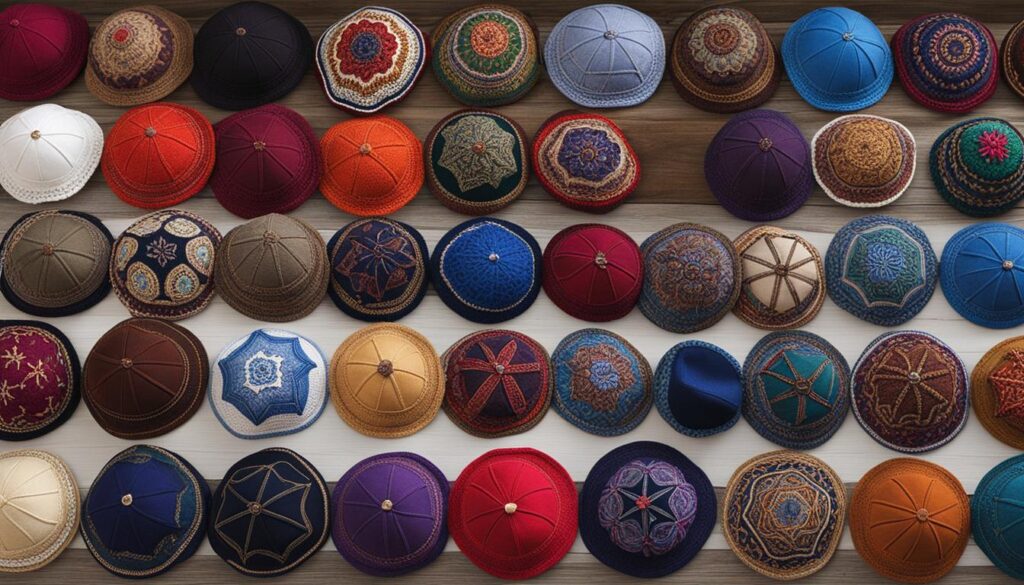
| Jewish Sects | Description |
|---|---|
| Orthodox and Conservative Jews | Plain, small kippah made from cloth |
| Hasidic Jews | Larger and more elaborate kippah styles with intricate designs and embellishments |
| Jewish Women | Varying styles from discreet to decorative, allowing Jewish women to express their religious identity |
Quote: “The different kippah styles among Jewish sects represent the unique customs and beliefs cherished by each group. From the smaller, discreet kippahs worn by Orthodox and Conservative Jews to the larger, ornate designs embraced by Hasidic Jews, and the choice of some Jewish women to wear kippahs, these variations reflect the diverse expressions of Jewish identity and religious observance.” – Rabbi David Cohen
Materials Used for Kippahs
Kippahs can be made from a variety of materials, each with its unique characteristics and significance. Traditional kippahs are often crafted from fabric, such as silk, cotton, or velvet, which symbolizes the rich history and traditions of Jewish culture. Fabric kippahs allow for customization through various colors, patterns, and embroidery, adding a touch of personal style and artistic expression.
In addition to fabric, kippahs can also be made from other materials, such as satin, leather, or even knitted yarn. Satin kippahs provide a lustrous and elegant appearance, making them well-suited for special occasions and festive celebrations. Leather kippahs, on the other hand, offer a durable and timeless option that can withstand everyday wear. Knitted yarn kippahs showcase a more casual and relaxed style, often favored by individuals who prefer a comfortable and lightweight head covering.
“The choice of material for a kippah can be influenced by personal preference, cultural customs, and the desired aesthetic. Whether crafted from traditional fabrics or more contemporary materials, the kippah serves as a meaningful symbol of Jewish identity and religious observance.”
To further enhance the kippah’s significance, some individuals may choose to adorn it with symbolic decorations, such as religious symbols or Hebrew inscriptions. These embellishments can further personalize the kippah and serve as a constant reminder of one’s faith and values.
Materials Used for Kippahs:
| Material | Description |
|---|---|
| Fabric | Made from silk, cotton, or velvet. Offers customization through colors, patterns, and embroidery. |
| Satin | Provides a lustrous and elegant appearance, suitable for special occasions and celebrations. |
| Leather | Offers a durable and timeless option for everyday wear. |
| Knitted Yarn | Showcases a casual and relaxed style, ideal for comfort and lightweight feel. |
Evolution of Kippahs Over Time
The kippah, a symbol of Jewish identity and religious observance, has undergone various changes in design and style throughout history. From its early origins to modern interpretations, the evolution of kippahs reflects the shifting cultural and fashion trends within the Jewish community. These changes have allowed individuals to express their faith and personal style while maintaining a connection to their religious heritage.
Historically, kippahs were often larger and more elaborate, featuring intricate designs and embellishments. These ornate styles were seen as a reflection of religious devotion and social status. Over time, however, kippahs have become smaller and simpler in design, aligning with contemporary fashion preferences and individual expression. Modern kippahs often incorporate patterns, colors, and embroidery, allowing wearers to personalize their head coverings while still honoring tradition.
The evolution of kippahs can also be attributed to changing cultural and social norms within the Jewish community. As Jewish identities become more diverse and multicultural, individuals may choose kippah styles that reflect their unique backgrounds and interests. This has led to the emergence of a wide range of kippah designs, each representing a specific cultural or regional tradition.
| Kippah Design | Historical Period |
|---|---|
| Elaborate and ornate designs | Ancient and medieval times |
| Simple and small designs | Modern era |
| Patterns, colors, and embroidery | Contemporary kippahs |
Overall, the evolution of kippahs highlights the adaptability of Jewish traditions to the contemporary world. As fashion trends change and cultural identities evolve, the kippah remains a cherished and meaningful aspect of Jewish tradition, embodying faith, identity, and a sense of community.
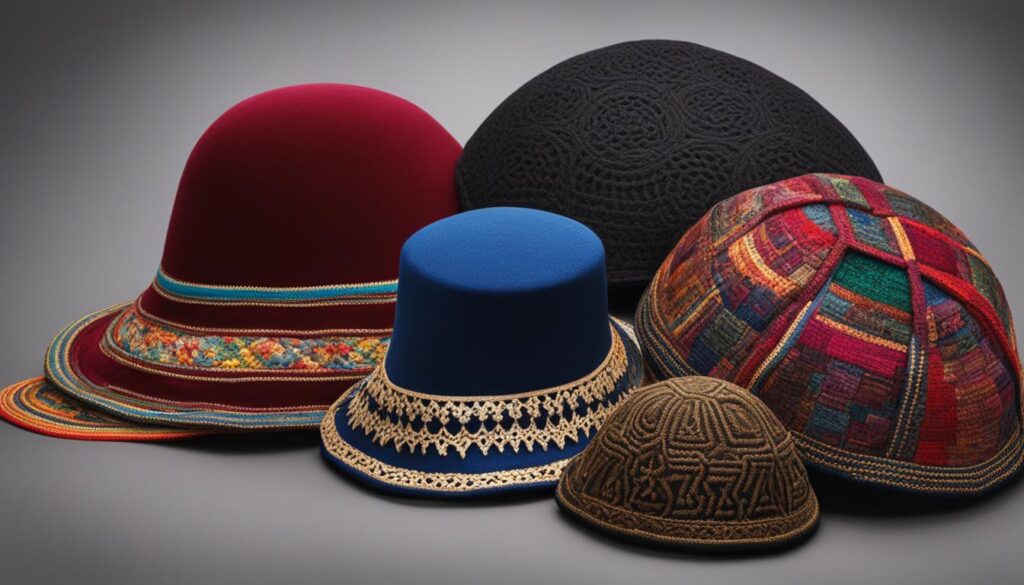
Variety in Kippah Designs
With the evolution of kippahs over time, a wide variety of designs have emerged, each with its own unique aesthetics and cultural significance. Some popular variations include:
- Knitted Kippahs: These kippahs are crafted using various knitting techniques, allowing for intricate patterns and designs. They are often favored by those who appreciate a handmade touch.
- Velvet Kippahs: Velvet kippahs are known for their soft texture and luxurious appearance. These kippahs are often worn during special occasions or religious ceremonies.
- Suede Kippahs: Made from high-quality suede, these kippahs offer a modern and refined look. They are popular among those looking for a sleek and sophisticated style.
- Customized Kippahs: Many individuals choose to personalize their kippahs by adding embroidered initials, names, or symbols that hold personal meaning. Customized kippahs allow for a unique expression of identity and individuality.
These diverse kippah designs demonstrate the richness and creativity within the Jewish community, showcasing the ability to adapt tradition to personal preferences and cultural influences.
Lesser-Known Kippah Varieties
In addition to the more commonly known kippah styles, there are lesser-known varieties that hold significance within specific Jewish communities. These unique kippah variations add diversity to the overall tapestry of styles and designs, showcasing the rich and vibrant traditions within Judaism. Here are a few lesser-known kippah varieties:
Sephardic Kippah:
The Sephardic kippah, also known as a Serugah, is often larger in size compared to the traditional kippah. It is commonly worn by Sephardic Jews, who originate from Spain, Portugal, and the Mediterranean region. The Serugah is typically crocheted or knitted, and its larger size covers a significant portion of the head, making it a distinct style among kippah variations.
Bukharan Kippah:
The Bukharan kippah is known for its colorful and large size, covering most of the head. It is traditionally worn by Bukharan Jews, who come from Central Asia, particularly Uzbekistan and Tajikistan. The vibrant colors and intricate patterns of the Bukharan kippah represent the cultural heritage and history of the Bukharan Jewish community.
Chabad Kippah:
The Chabad kippah is associated with the Chabad-Lubavitch movement, which follows the Chassidic tradition. It is typically made of velvet and has a unique shape, tapering towards the top. The Chabad kippah is often black, showcasing a more formal and traditional style compared to other kippah variations.
| Kippah Variety | Description |
|---|---|
| Sephardic Kippah | Larger in size, crocheted or knitted |
| Bukharan Kippah | Colorful and large, representing Central Asian heritage |
| Chabad Kippah | Made of velvet, unique shape tapering towards the top |
These lesser-known kippah varieties highlight the intricate and diverse nature of Jewish traditions. They not only serve as religious headwear but also carry cultural significance, connecting individuals to their specific communities and histories.
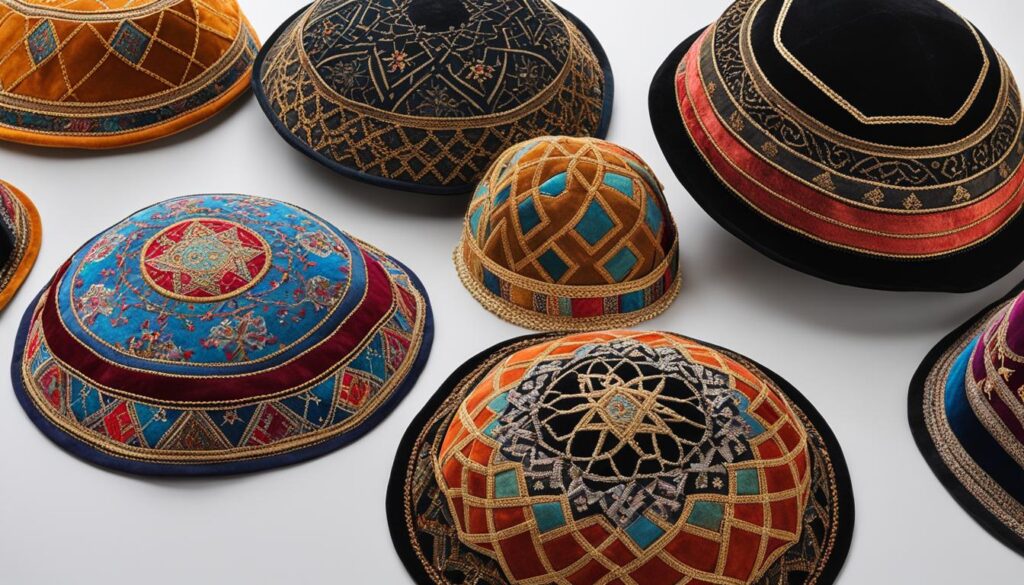
A Path to Unity: A Unified Hat Standard?
The concept of a unified hat standard has been proposed as a symbolic representation of shared values and mutual understanding between Jewish and Muslim communities. Combining elements of the kippah, worn by Jewish men, and the Muslim kufi, such a head covering could serve as a tangible expression of unity, transcending historical conflicts and fostering dialogue and acceptance.
While this idea remains hypothetical, it highlights the potential for finding common ground and promoting interfaith collaboration. The kippah and the kufi both hold deep religious and cultural significance within their respective communities, and integrating their elements could symbolize a commitment to shared values such as faith, respect, and community.
“The idea of a unified hat standard is a powerful way to bridge the gap between different religious communities and promote understanding,” says Dr. Sarah Cohen, an interfaith scholar. “It would send a strong message of solidarity and respect, emphasizing the similarities rather than the differences between faith traditions.”
However, there are practical considerations and sensitivities that need to be taken into account when discussing such a proposal. Both the kippah and the kufi have their own unique cultural and religious contexts, and any attempt to combine them would require careful consultation and collaboration with Jewish and Muslim leaders, scholars, and communities.
While the idea of a unified hat standard is an intriguing one, it is important to approach it with respect, sensitivity, and open dialogue. It represents a potential avenue for fostering unity and understanding between different faith communities, but the complexities involved should be acknowledged and addressed in a thoughtful and inclusive manner.

Table: Comparing the Kippah and the Kufi
| Kippah | Kufi |
|---|---|
| Worn by Jewish men | Worn by Muslim men |
| Signifies respect for God | Symbolizes submission to God |
| Comes in various styles and sizes | Typically a knitted cap |
| Often made from fabric or knitted yarn | Usually made from knitted or crocheted fabric |
The Significance of Wearing the Kippah
Wearing the kippah holds deep spiritual and personal significance for those who choose to don it. It represents a tangible connection to Jewish tradition, a visible declaration of religious observance, and a symbol of Jewish identity. By adorning this religious headwear, individuals actively participate in the ancient customs and rituals that have been passed down through generations.
The kippah serves as a constant reminder to strive for holiness, act with humility, and uphold the values of Judaism in daily life. It signifies a commitment to living a life of faith and integrity, as well as a dedication to upholding the principles and teachings of the Jewish faith. Wearing the kippah is an outward expression of one’s connection to Jewish identity and serves as a visual testament to one’s devotion.
“The kippah is not just a mere piece of cloth; it is a symbol of prayer, a token of holiness, and a constant reminder of our connection to God,” said Rabbi David Cohen.
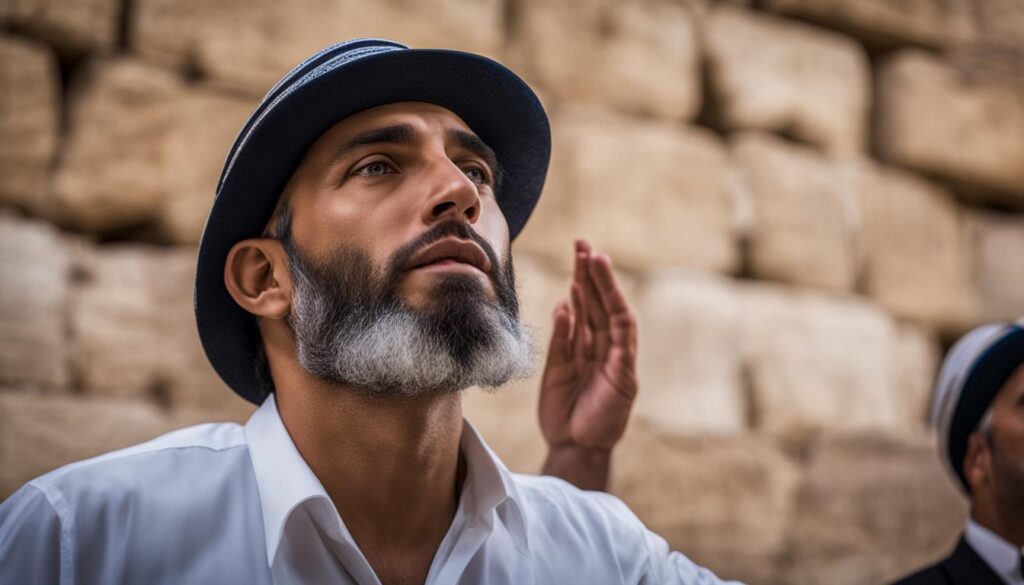
The act of wearing the kippah also fosters a sense of unity and belonging within the Jewish community. When individuals wear the kippah, they are instantly recognizable as fellow believers, creating a sense of camaraderie and solidarity. It serves as a visual cue that indicates shared values and beliefs, facilitating connections and forming bonds among individuals who may otherwise be strangers.
Overall, the kippah is not just a religious head covering; it is a symbol of spirituality, identity, and communal belonging. Those who choose to wear it embrace their heritage, uphold their faith, and declare their commitment to a life guided by Jewish principles. The significance of wearing the kippah is deeply ingrained in Jewish culture and remains an important aspect of Jewish tradition.
Conclusion
In conclusion, the kippah, also known as the yarmulke or skullcap, holds immense cultural and religious significance in Jewish tradition. It is worn by Jewish men as a sign of respect and reverence for God during synagogue services and other religious occasions. The kippah serves as a tangible connection to Jewish identity and a reminder of one’s connection to the divine and sense of community among believers.
Throughout history, the kippah has evolved in its design and style, reflecting changing cultural and fashion trends within the Jewish community. From larger and more elaborate designs to smaller and simpler ones, modern kippahs often incorporate patterns, colors, and embroidery, allowing individuals to personalize their religious headwear.
There are also variations in kippah styles among different Jewish sects. Orthodox and some Conservative Jews typically wear plain, small kippahs, while Hasidic Jews often don larger and more elaborate styles. It is worth mentioning that some Jewish women also choose to wear kippahs as a testament to their faith.
The materials used for kippahs vary, ranging from traditional fabric to satin, velvet, leather, or knitted yarn. The choice of materials can be influenced by personal preference, cultural customs, and desired aesthetics.
In summary, the kippah is a cherished and meaningful aspect of Jewish tradition. From its historical roots to its potential for unity and shared values, it serves as a symbolic representation of faith, reverence, and community. By wearing a kippah, individuals express their connection to Jewish identity and their commitment to living a life of faith and integrity.
FAQ
What is a kippah?
A kippah, also known as a yarmulke or skullcap, is a head covering worn by Jewish men as a sign of respect and reverence for God during synagogue services and other religious occasions.
When are kippahs worn?
Kippahs are worn during synagogue services and other religious occasions to show respect and maintain a constant connection to one’s faith.
What does a kippah symbolize?
A kippah symbolizes a sign of respect for God, a recognition of His presence, and a reminder to act with humility and uphold the values of Judaism.
Are there different styles of kippahs?
Yes, there are variations in the styles and designs of kippahs among different Jewish sects. Orthodox and some Conservative Jews typically wear a plain, small kippah, while Hasidic Jews often wear larger, more elaborate styles.
What materials are kippahs made from?
Kippahs can be made from various materials such as cloth, satin, velvet, leather, or knitted yarn.
How have kippah designs evolved over time?
Kippah designs have evolved, reflecting changing cultural and fashion trends. Modern designs may incorporate patterns, colors, and embroidery to add personal touches.
Are there lesser-known kippah styles?
Yes, there are lesser-known kippah styles that hold significance within specific Jewish communities, such as the Bukharan kippah known for its colorful and large size.
Is there a unified hat standard combining kippah and the Muslim kufi?
While it remains a hypothetical idea, the concept of a unified hat standard has been proposed as a symbolic representation of shared values and mutual understanding between Jewish and Muslim communities.
What does wearing a kippah signify?
Wearing a kippah signifies a tangible connection to Jewish tradition, a visible declaration of religious observance, and a symbol of Jewish identity.
What is the significance of the kippah?
The kippah holds deep spiritual and personal significance, representing faith, reverence, and community within Jewish culture.


